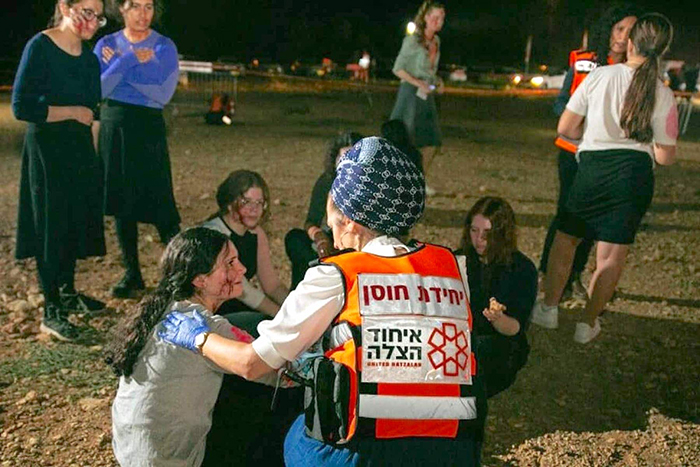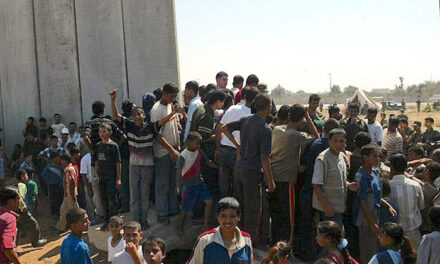Psychotrauma and crisis response unit training during a simulated drill in Israel run by United Hatzalah. Photo courtesy of United Hatzalah.
Ever since 6:29 a.m. on Oct. 7, 2023, it’s as if Israelis have been riding a never-ending high-speed train of trauma, each day punctuated by the sounds of sirens, buzzing drones, artillery fire and fighter jets. There are the incessant booms of falling shrapnel, exploding Iron Dome interceptors, stark TV reports, phone and online messages with family and friends—all about the missing, the injured, the murdered, the kidnapped. And the dead.
Images have seared into the collective memory: mutilated bodies stained with blood; raw terror etched on the faces of fleeing concertgoers across a vast field; Shani Louk’s lifeless body paraded on the streets of Gaza; Hersh Goldberg-Polin, whose arm was maimed by an RPG, or the white pick-up truck filled with armed Hamas terrorists driving through the streets of Sderot on what was supposed to be a quiet Saturday morning.
The examples, and the horror of the massacres and pogroms at the Supernova music festival and more than 20 towns and villages of Israel’s southwest reverberates far beyond its borders.
In its savage cruelty, in its deliberate targeting of innocent civilians, in its perverse celebration of violence broadcasted for the world to see, the Oct. 7 attack was a declaration of war by Hamas and its sponsors, not just on Israel, but on the values that underpin civilized society.
The audio-visual trauma is a major part of the weaponry in this war—these are not mere byproducts of the attack, but central to its aim of sowing fear, helplessness, and long-lasting trauma.
As Prof. Ofrit Shapira-Berman, a historian of Israeli trauma, explains, “Oct. 7 is Israel’s biggest trauma yet, not only because of its objective magnitude, but also because it echoes our past traumas—the Holocaust and the Yom Kippur War, in terms of the government’s betrayal and failure. The fact that Oct. 7 is experienced by many as a byproduct of the government’s actions has broken the trust of many citizens in the government and the state.”
Forged In Trauma
For Israelis, national trauma is a familiar companion. The inception of the modern State of Israel is inextricably bound with the devastation of the Holocaust, which saw six million Jews systematically murdered.
Rising from those ashes, each subsequent war and attack has resulted in Israel’s enduring accumulative post-traumatic stress—the War of Independence, Six-Day War, Yom Kippur War, the Lebanon Wars, the Intifadas; bombings, knife attacks and car-rammings—seven decades of indelible dents on the collective psyche.
“The events of Oct. 7 result in an estimated 300,000 additional patients who require treatment by trained professionals,” says Shapira-Berman.
This legacy has shaped a society where schoolchildren practice rocket drills. In the 1990s, they were taught to don gas masks in preparation for biochemical warfare and, today, how to take cover in shelters from incoming missiles.
Memorializing the fallen is woven into the fabric of the Israeli public space. This shared history of trauma binds together Israelis across religious, ethnic and political divides.
The scale and brutality of the Oct. 7 attack and its aftermath reactions have ushered in a new level of national trauma into Israel’s battered consciousness, be it the slaughter of innocent families, the shattering of the idea that the home is a safe haven, the agony over the fate of the hostages, and the global campaigns to delegitimize and gaslight the Israeli narrative by major organizations such as the United Nations and individuals alike.
Beyond the initial attack, the hate and anti-Semitism running rampant anywhere from major news networks to the campuses of the biggest universities have shocked Israelis to their core.
No Escape From Horrors
Experts say the constant multimedia conversation can cause a state of hypervigilance, anxiety, flashbacks and difficulty functioning for many, causing some to slip into dissociative states.
“We are seeing a shared reality where all Israelis are victims,” explains Dr. Rony Berger, a clinical psychologist specializing in community resilience. “This leads most Israelis to experience symptoms of acute stress, even if they were not directly impacted.”
For those near the Gazan and Lebanese borders, and indeed across most of Israel with the proliferation of threats on multiple fronts, the whole country is impacted by the terrorizing fear of attacks from land, sea and air as well as online.
Mental health professionals are treating a nation reeling from audio-visual trauma on an unprecedented scale. With one in three Israelis exhibiting PTSD symptoms, new treatment approaches are being pioneered, such as virtual reality therapy, to help patients process traumatic memories more safely.
The Psychological Toll
The war’s psychological impact has cut across all sectors of Israeli society. Soldiers including reservists grapple with the horrors witnessed on the battlefield. Families of the murdered and wounded, including young children, face a lifetime of grief and challenges. Survivors of the attacks relive the terror in flashbacks and nightmares.
Psychotherapist Dr. Shlomit Bresler, who has treated dozens of bereaved families and victims, describes the long road ahead. “First, we focus on stabilization and establishing a sense of safety. With the war still raging, that is a long way off for most.”
Bresler emphasizes the collective nature of the trauma: “We are living in a mass-trauma situation. The entire population is under trauma and various types, but this started before Oct. 7. The healing process can only come from deeper sociological and political changes.”
Berger reflects, “The families of hostages are suffering the most, their lives completely upended, consumed by anguish and despair with each passing day.”
Dr. Yehezkel Caine, president of Herzog Medical Center in Jerusalem, describes the situation as a “psychological and emotional catastrophe.”
He warns of a “coming tsunami of mental health problems” as people return to the remains of their communities, confronting the death and destruction, and soldiers return with physical and emotional scars.
“Already our main clinics are overflowing,” Caine reports. He emphasizes the shortage of trained therapists proficient in trauma as a major challenge, necessitating extensive training programs and support for the mental health professionals themselves to prevent secondary trauma and burnout.
“The civilian sector is way behind, both due to a lack of trained therapists, little government support and a lack of infrastructure, due to years of neglect of the mental health sector,” he explains.
Long-Term Needs
Looking ahead, Caine emphasizes the critical need for investment in mental health infrastructure and resources to address the long-term impacts of this unprecedented national trauma.
“Unfortunately, there is no magic wand that we can wave to produce good-quality therapists. It takes at least five years to produce a psychiatrist from a qualified doctor. A clinical psychologist can take a similar period. Clinical social workers also require extensive training,” he notes.
Caine also underscores the lack of physical facilities, with Herzog Medical Center’s new clinic building already overflowing just two years after opening.
The Road Ahead
For a society so deeply shaped by its history of existential threats, regaining a sense of safety and security on both the individual and collective level will be a long and difficult process.
“We need a ‘mental Iron Dome’ to protect Israelis from this bombardment on our psyche,” asserts Prof. Mooli Lahad, a leading expert on coping and resilience. “That means embedding mental health professionals in schools, workplaces, community centers, building a societal infrastructure of psychological support and resilience.”
Lahad provides concrete examples of what a “mental Iron Dome” could entail: “It is possible through the resilience centers and the government services such as community welfare and education.
“This model is based on the ‘cascade’ model: We train master trainers who commit themselves to training others. If we manage to train 40 trainers who each commit to training 25 trainees, we get around 1,000 trained therapists.”
He also suggests leveraging technology: “One other method that we developed is an app where the therapist meets the client online, making it accessible to those who can’t leave home for various reasons.
“The recent pre-war civic conflict [over judicial reform] brought to the surface what sociologists warned us about—the growing rift in Israeli society,” Lahad reflects.
“This, combined with the feeling that the state is changing course, the global loss of trust in authorities, the social media ‘poison’ of fake news, the colossal failure of the IDF to prevent the Oct. 7 Hamas onslaught, the ongoing inability of the government to resolve the conflict and bring an end to the attacks, and the burning issue of the hostages, is causing attrition in the morale and mental health of Israelis.”
As Israel marks one year since the Oct. 7 Hamas onslaught, the nation remains haunted by the sounds and images of that horrific day and the ensuing war.
“It is, therefore, a long road to recovery. Because of the mistrust in authorities, we believe the recovery will have to be bottom-up—back to the local communities and human relationships,” Lahad concludes.
Shapira-Berman offers a powerful call to action: “I cannot be hopeless about our future as a nation and a society. The Holocaust gave us a nation of our own. Oct. 7 has to have a similar impact on our lives. It is clear that no other nation or people has such a powerful ability to transform suffering and trauma into strength and success.
“But ultimately, emerging from this crisis will take a sustained, society-wide effort, working together, from the grassroots community level up to the highest echelons of leadership,” she says.
NATAL’s Frontline
NATAL—The Israel Trauma and Resiliency Center has been at the forefront of addressing the psychological fallout of the Oct. 7 attacks. The organization operates dedicated helplines for civilians and veterans, funded by the Ministry of Defense.
Immediately following Oct. 7, these helplines saw an unprecedented surge in calls, with more than 23,000 in the first month alone. To date, NATAL’s helplines have received over 53,000 calls, with dramatic spikes during escalations such as the Iran missile attacks.
To meet the increased demand and complexity of needs, NATAL has significantly expanded its workforce, developing innovative therapeutic approaches such as neurofeedback therapy and tailored interventions for specific populations like soldiers’ families.
Originally published by Israel Hayom.








